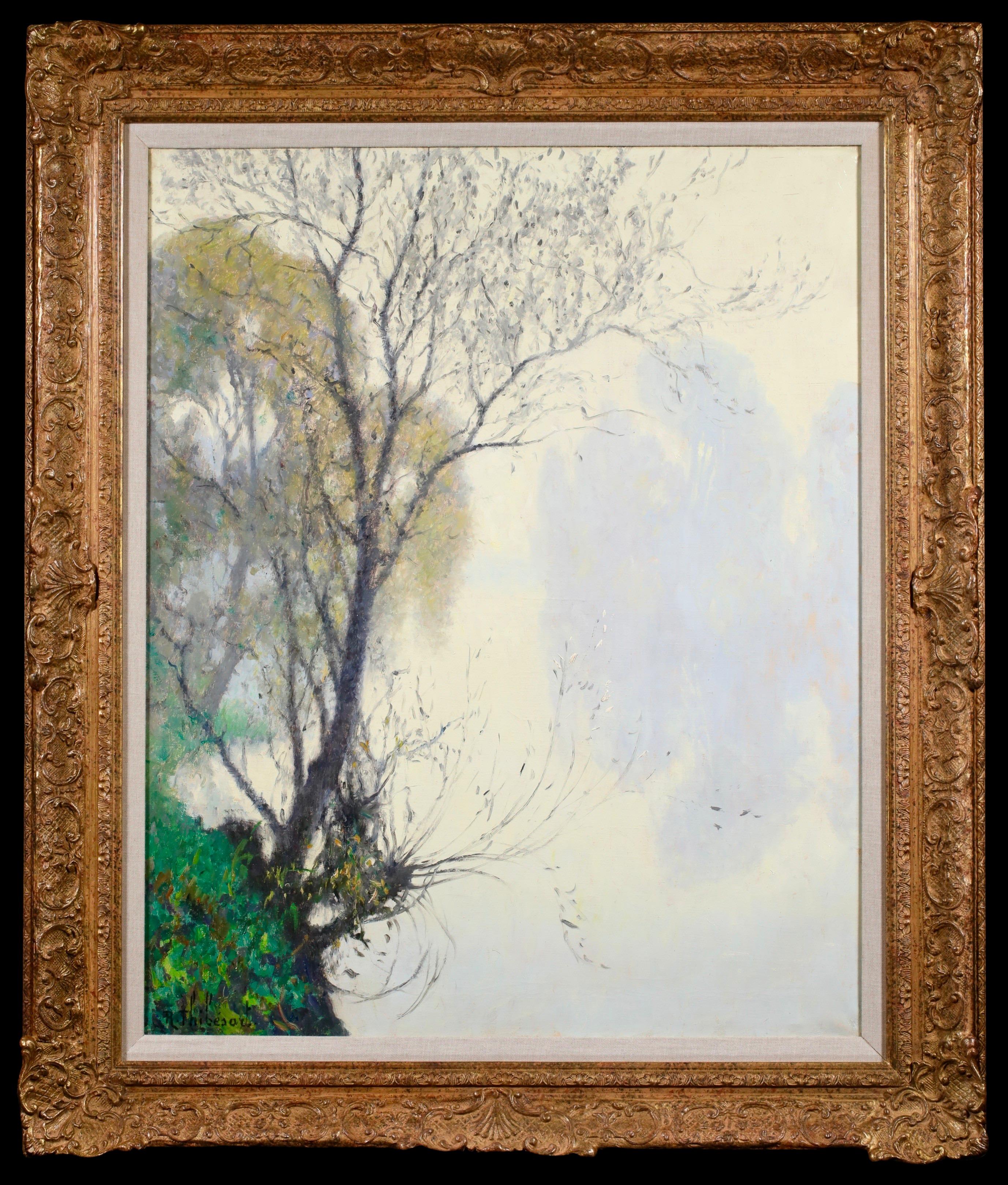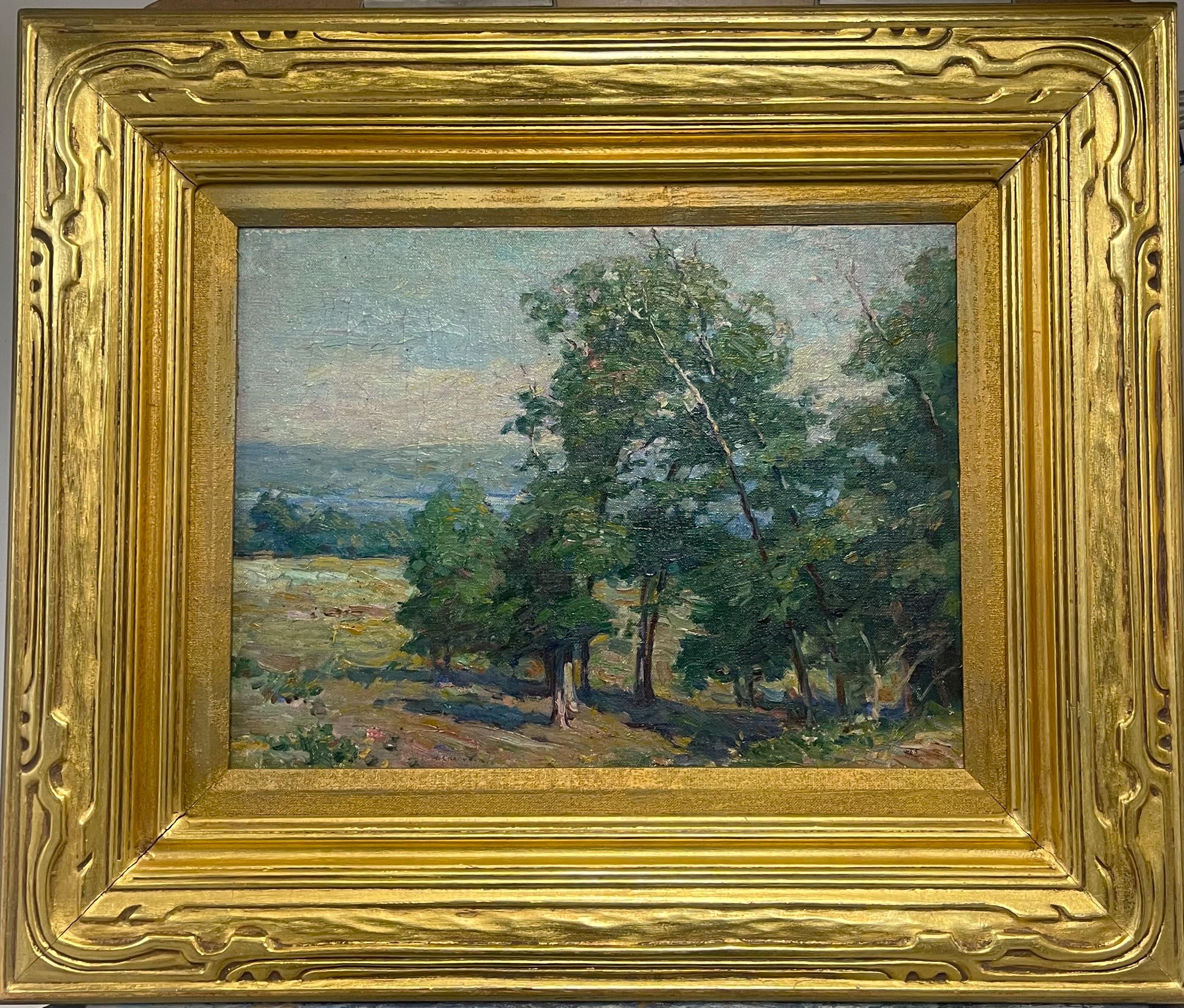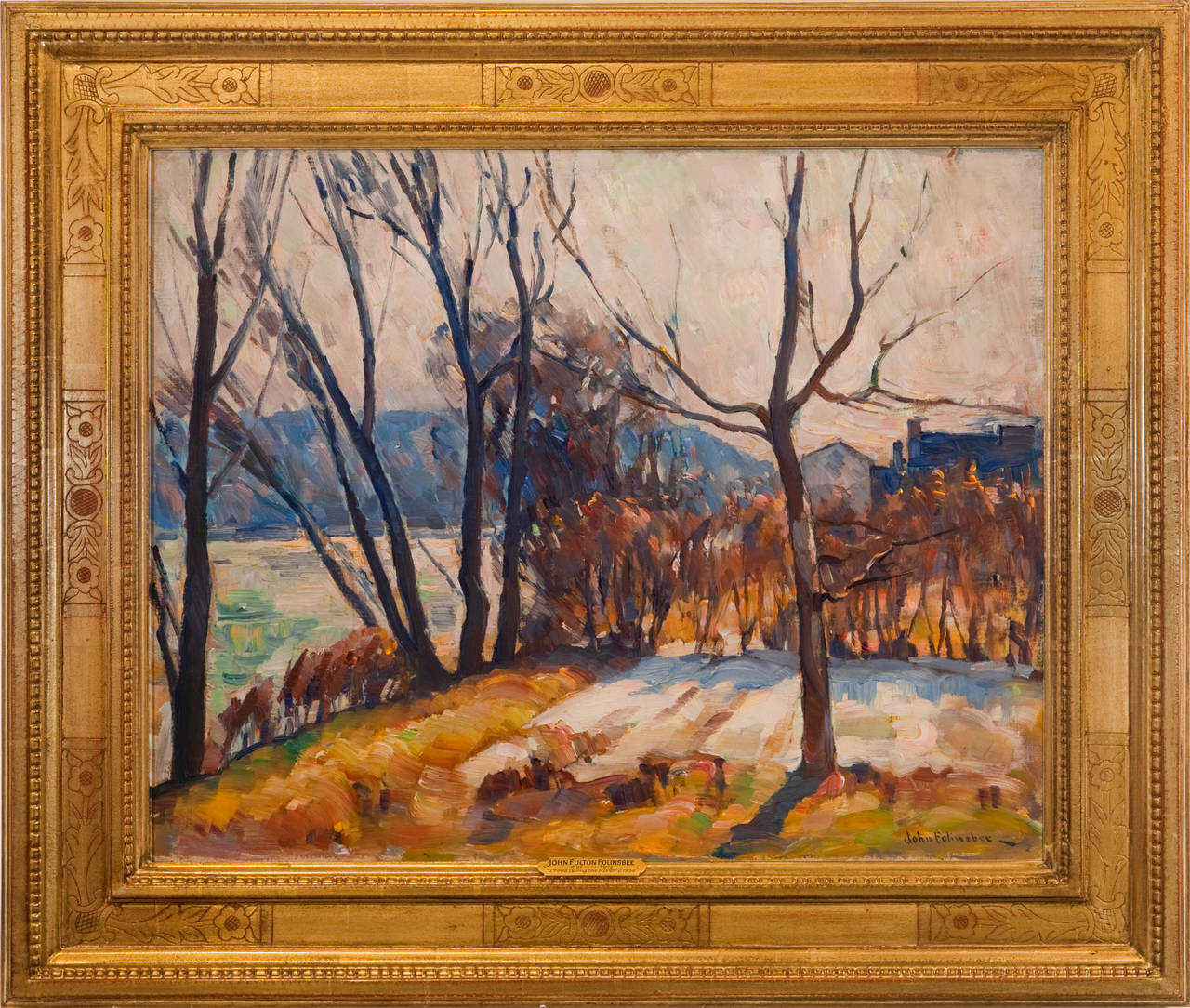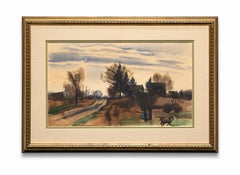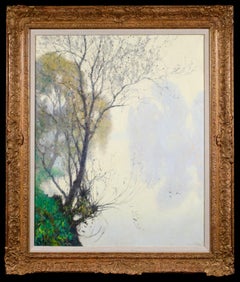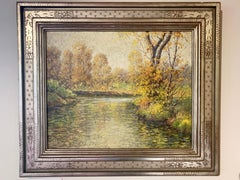Items Similar to Henry Wallace Methven "Impressionist Landscape" Water, Trees Summer Reflection
Want more images or videos?
Request additional images or videos from the seller
1 of 8
Harry Wallace MethvenHenry Wallace Methven "Impressionist Landscape" Water, Trees Summer Reflection1902
1902
$8,900
£6,759.77
€7,809.77
CA$12,473.67
A$13,960.38
CHF 7,286.25
MX$170,244.73
NOK 93,254.05
SEK 88,276.90
DKK 58,283.26
Shipping
Retrieving quote...The 1stDibs Promise:
Authenticity Guarantee,
Money-Back Guarantee,
24-Hour Cancellation
About the Item
Impressionist Landscape" is an exquisitely peaceful late summer scene along the banks of a quiet river. The dappling yellow and green leaves and the spots of blue sky give the perfect impressionistic feel to the scene. Impressionism was a style or movement in painting originating in France in the 1860s, characterized by a concern with depicting the visual impression of the moment, especially in terms of the shifting effect of light and color. Methven captured this impression perfectly. It is as fresh today as when it was painted in 1902 so much so that you can almost hear the rustle of the leaves and see the shifting light. The gold gilt frame is original to the piece. Without the frame the piece measures 20 h x 16 w. It is signed by the artist.
Methven was born in Philadelphia, Pennsylvania. In the 1930's he moved to Chicago, Illinois, where he painted with other area Chicago artists and showed at The Art Institute of Chicago. He spent his summers in Benton Harbor, Michigan, along Lake Michigan. He is known for his landscapes and water scenes. Michigan has numerous rivers, creeks and small lakes and Methven would have had a wealth of scenes to draw upon for his numerous oil paintings.
He studied under Henry Fenton Spread who taught at the School of the Art Institute of Chicago and later founded Spread's Art Academy. In 1902, this academy became the Chicago Academy of Fine Arts. Spread was named the first president of the Chicago Society of Artists in 1889. Known primarily as a portraitist, Spread also painted landscape and genre scenes. Although a skilled artist, he did not exhibit widely; his primary legacy being fostering a love of art in Chicago. Fellow artist (and former student of Spread), Ralph Clarkson, the noted Chicago society portrait painter, stated that Spread' s "fine and advice formed the careers of the men who were not only to achieve prominence as artists, but to occupy leading places as art teachers". Harry Wallace Methven was one of those men and became an art teacher. Both Methven and Spread resided in Paris during their careers and it is reported that it was in Paris that Methven took classes with Spread. Methven was a member of the Alliance of American Artists in Paris (AAA) were he lived as an expatriate for twenty years.
Methven also studied under the famous American painter, John Henry Twachtman, best known for his impressionist landscapes. Though his painting style varied widely through his career, art historians consider Twachtman's style of American Impressionism to be among the more personal and experimental of his generation. He was a member of "The Ten", a loosely allied group of American artists dissatisfied with professional art organizations, who banded together in 1898 to exhibit their works as a stylistically unified group.
It is also reported that Methven studied under Kenyon Cox while living in Boston. They have both been associated with the Pennsylvania Academy of Fine Arts where Methven attended classes and Cox taught at one time.
James Carroll Beckwith was another famous American painter during this period and is considered another of Methven’s teachers. Beckwith was in Chicago for a period of time painting a mural on one of the domes in the Liberal Arts Building at the World Columbian Exposition in Chicago in 1893. It may have been during this time that he also taught at the School of the Art Institute of Chicago and had Methven as a student.
It appears there is a discrepancy in Methven's birthdate sometimes being given 1864 and other times 1875. The 1864 date is most frequently quoted in historical notes regarding Methven making him about 38 when "Impressionist Landscape" was painted.
- Creator:Harry Wallace Methven (1864 - 1947)
- Creation Year:1902
- Dimensions:Height: 29.5 in (74.93 cm)Width: 25.5 in (64.77 cm)
- Medium:
- Movement & Style:
- Period:
- Condition:
- Gallery Location:Detroit, MI
- Reference Number:1stDibs: LU128616051322
About the Seller
5.0
Vetted Professional Seller
Every seller passes strict standards for authenticity and reliability
Established in 2014
1stDibs seller since 2019
108 sales on 1stDibs
Typical response time: 12 hours
- ShippingRetrieving quote...Shipping from: Detroit, MI
- Return Policy
Authenticity Guarantee
In the unlikely event there’s an issue with an item’s authenticity, contact us within 1 year for a full refund. DetailsMoney-Back Guarantee
If your item is not as described, is damaged in transit, or does not arrive, contact us within 7 days for a full refund. Details24-Hour Cancellation
You have a 24-hour grace period in which to reconsider your purchase, with no questions asked.Vetted Professional Sellers
Our world-class sellers must adhere to strict standards for service and quality, maintaining the integrity of our listings.Price-Match Guarantee
If you find that a seller listed the same item for a lower price elsewhere, we’ll match it.Trusted Global Delivery
Our best-in-class carrier network provides specialized shipping options worldwide, including custom delivery.More From This Seller
View AllHelmut Gransow Landscape w/House & Barn "Springtime Reflections No. I"
Located in Detroit, MI
SALE ONE WEEK ONLY
“Springtown Reflections No. I” depicts the moment of change in the weather moving from harsh winter to the first warming days of spring melting the snow. The title suggests a moment to pause in farm life before the coming spring planting and also suggests a time of mental reflection on life and work. The puddles of melting snow reflect the buildings in the scene. The muted colors and slightly off kilter structures cause the buildings to appear worn but sturdy, a soft idyllic scene of rural life.
Helmut Gransow...
Category
1970s Modern Landscape Paintings
Materials
Linen, Oil
Thomas M Nicholas Winter Country Scene Northeast Oil
Located in Detroit, MI
SALE ONE WEEK ONLY
The untitled oil painting of a quiet country winter scene is a typical subject matter for T. M. Nicholas who is considered by many to be among the most prominent painter of his generation and specifically of the Rockport School of Art. Painting is signed in the lower right front corner.
He grew up admiring the rugged beauty of the U.S. northeast coastline especially the landscapes of coastal New England. His father, esteemed painter, Tom Nicholas...
Category
1990s Landscape Paintings
Materials
Canvas, Oil
D. P. Weier Monoprint Oil Landscape "Birch Forest"
Located in Detroit, MI
SALE ONE WEEK ONLY
“Birch Forest” is a monotype oil. The process is the simplest form of printmaking in a way because the artist does not etch or carve into a plate. Instead, a mono...
Category
20th Century American Impressionist Landscape Prints
Materials
Paper, Oil
Charles Culver Landscape "Late Afternoon Landscape" Watercolor on Paper
Located in Detroit, MI
“Late Afternoon Landscape” is set in the golden light of evening painted in the mid-west town of Utica, Michigan. It has the atmosphere of when work is done and peace and quiet blanket the countryside. The The farm machinery has ceased its racket as has the family dog wandering about for one last sniff. This piece has been professionally reframed with acid-free matting and conservative glass.
In a 1952 Detroit Free Press article, entitled “Artist Explains His Work,” Culver was asked why he painted the way he did. He stated: “I try to ‘see’ though not too exactly; I try to think though not too ponderously; I feel emotion yet I try not to become overwrought. I interpret rather than describe, and design rather than depict. I work with values, not light and shade; hence, when I am successful, I achieve substance rather than three-dimensional form, and this satisfies me as being wholly sufficient. In my work I wish to be serious without becoming a bore, exuberant without being frivolous, humorous without being silly. I believe that good paintings are conceived, not contrived; and I am interested in art much more than in pictures.”
Charles Culver...
Category
1940s Naturalistic Landscape Drawings and Watercolors
Materials
Paper, Watercolor
Robert Burkert Lithograph Landscape "Late Light" Poetic
By Robert Burkert
Located in Detroit, MI
"Late Light" by Robert Burkert is a lithograph landscape by the master printmaker that depicts a clearing with autumn/winter trees in the subtle but vib...
Category
Late 20th Century Contemporary Landscape Prints
Materials
Lithograph
"Untitled Landscape" Orange, Green, Serigraph, Signed Lower Front
By Pierre Alechinsky
Located in Detroit, MI
SALE ONE WEEK ONLY
“Untitled Landscape” is a serigraph in various shades of green and orange. Although it has an Art Nouveau feel to it, it can be described as Lyrical Abstraction. ...
Category
Mid-20th Century Abstract Expressionist Landscape Prints
Materials
Paper, Screen
You May Also Like
Summertime River Landscape by 19th century American Impressionist
Located in Doylestown, PA
A summertime landscape along the river by 19th century, American painter. The 12 x 16 inches, oil on paper is framed and matted behind glass, and signed "W. Taylor Thomson" in the lo...
Category
Late 19th Century American Impressionist Landscape Paintings
Materials
Paper, Oil
Reflections - Post Impressionist Landscape Oil Painting by Raymond Thibesart
By Raymond Thibesart
Located in Marlow, Buckinghamshire
Signed oil on canvas landscape circa 1940 by French post impressionist painter Raymond Thibesart. The piece depicts a lake on a grey misty day. There is a bare tree in the front of t...
Category
1940s Post-Impressionist Landscape Paintings
Materials
Canvas, Oil
Reflections, American Impressionist Landscape by Stream, Oil on Canvas
By Albert Van Nesse Greene
Located in Doylestown, PA
"Reflections" is an Impressionist landscape by American painter Albert Van Nesse Greene. The painting is a 13" x 16" oil on canvas, framed in a white gold reproduction frame, signed and dated "A V...
Category
Early 20th Century American Impressionist Landscape Paintings
Materials
Canvas, Oil
Impressionist William Chadwick British/American Landscape with Trees Old Lyme Ct
By William Chadwick
Located in Chesterfield, NJ
Landscape with Trees
Oil/Canvas
12 x 16 unframed, 21.5 x 25 framed
Painting is in good condition, signed bottom left margin with craquelure in the clouds as shown. Housed in beautif...
Category
21st Century and Contemporary Impressionist Landscape Paintings
Materials
Oil
"Trees Along the River"
By John Fulton Folinsbee
Located in Lambertville, NJ
Jim’s of Lambertville Fine Art Gallery is proud to present this piece by John Fulton Folinsbee (1892 - 1972).
One of the finest painters to embark upon the New Hope Art Colony, John...
Category
1930s American Impressionist Landscape Paintings
Materials
Canvas, Oil
Impressionistic Landscape Oil Painting by Michael Budden Beautiful Light Pond
By Michael Budden
Located in Chesterfield, NJ
Early Autumn Light, Lily Pond
oil/canvas
16 x 20 image
An oil painting on canvas that showcases a beautiful country pond in early fall colors. This painting was painted en plein air ...
Category
21st Century and Contemporary Impressionist Landscape Paintings
Materials
Oil
More Ways To Browse
Antique Reflections
Antique Watering Can
Water Gilt Frame
Wallace Antique
Aaa Sign
Kenyon Cox
Henry Wallace
Oil Paintings By Kenyon
James Cox
Fenton Blue
John Henry Twachtman
Metz Landscape Paintings
Oil Painting Eiffel Tower
Rainy Day Vintage
Robert Heyer
Texas Bluebonnet Artists
Texas Bluebonnet Landscape Painting
Texas Bluebonnet Paintings

